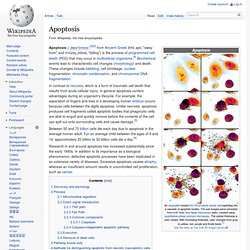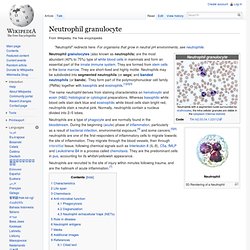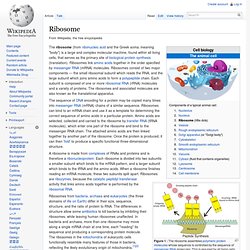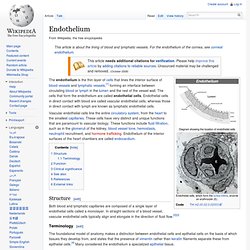

Apoptosis. In contrast to necrosis, which is a form of traumatic cell death that results from acute cellular injury, in general apoptosis confers advantages during an organism's lifecycle.

For example, the separation of fingers and toes in a developing human embryo occurs because cells between the digits apoptose. Unlike necrosis, apoptosis produces cell fragments called apoptotic bodies that phagocytic cells are able to engulf and quickly remove before the contents of the cell can spill out onto surrounding cells and cause damage.[5] Research in and around apoptosis has increased substantially since the early 1990s. In addition to its importance as a biological phenomenon, defective apoptotic processes have been implicated in an extensive variety of diseases. Excessive apoptosis causes atrophy, whereas an insufficient amount results in uncontrolled cell proliferation, such as cancer. Discovery and etymology[edit] German scientist Carl Vogt was first to describe the principle of apoptosis in 1842. Neutrophil granulocyte. 3D Rendering of a Neutrophil Neutrophil granulocytes (also known as neutrophils) are the most abundant (40% to 75%) type of white blood cells in mammals and form an essential part of the innate immune system.

They are formed from stem cells in the bone marrow. They are short-lived and highly motile. Neutrophils may be subdivided into segmented neutrophils (or segs) and banded neutrophils (or bands). They form part of the polymorphonuclear cell family (PMNs) together with basophils and eosinophils.[1][2][3] The name neutrophil derives from staining characteristics on hematoxylin and eosin (H&E) histological or cytological preparations. Neutrophils are recruited to the site of injury within minutes following trauma, and are the hallmark of acute inflammation.[7] Characteristics[edit] Neutrophil granulocytes have an average diameter of 12-15 micrometers (µm) in peripheral blood smears. DNA polymerase. A DNA polymerase is a cellular or viral enzyme that synthesizes DNA molecules from their nucleotide building blocks, distinguished from RNA polymerase and other polymerases.

DNA polymerases are essential for DNA replication, and usually function in pairs while copying one double-strand DNA molecule into two double-strand DNAs in a process termed semiconservative DNA replication. DNA polymerases also play key roles in other processes within cells, including DNA repair, genetic recombination, reverse transcription, and the generation of antibody diversity via the specialized DNA polymerase, terminal deoxynucleotidyl transferase. DNA polymerases are widely used in molecular biology laboratories, notably for the polymerase chain reaction (PCR), DNA sequencing, and molecular cloning. Deoxyribonucleotide. A deoxyribonucleotide is the monomer, or single unit, of DNA, or deoxyribonucleic acid.

Each deoxyribonucleotide comprises three parts: a nitrogenous base, a deoxyribose sugar, and one phosphate group.[1] The nitrogenous base is always bonded to the 1' carbon of the deoxyribose, which is distinguished from ribose by the presence of a proton on the 2' carbon rather than an -OH group. The phosphate groups bind to the 5' carbon of the sugar. When deoxyribonucleotides polymerize to form DNA, the phosphate group from one nucleotide will bond to the 3' carbon on another nucleotide, forming a phosphodiester bond via dehydration synthesis. New nucleotides are always added to the 3' carbon of the last nucleotide, so synthesis always proceeds from 5' to 3'. References[edit] Jump up ^ Coghill, Anne M.; Garson, Lorrin R., ed. (2006). External links[edit] Deoxyribonucleotides at the US National Library of Medicine Medical Subject Headings (MeSH) Transfer RNA. The interaction of tRNA and mRNA in protein synthesis.

The specific nucleotide sequence of an mRNA specifies which amino acids are incorporated into the protein product of the gene from which the mRNA is transcribed, and the role of tRNA is to specify which sequence from the genetic code corresponds to which amino acid.[1] One end of the tRNA matches the genetic code in a three-nucleotide sequence called the anticodon. The anticodon forms three base pairs with a codon in mRNA during protein biosynthesis. The mRNA encodes a protein as a series of contiguous codons, each of which is recognized by a particular tRNA. On the other end of the tRNA is a covalent attachment to the amino acid that corresponds to the anticodon sequence.
Structure[edit] Secondary cloverleaf structure of tRNAPhe from yeast. Tertiary structure of tRNA. Messenger RNA. Synthesis, Processing and Function[edit] The brief existence of an mRNA molecule begins with transcription, and ultimately ends in degradation.

During its life, an mRNA molecule may also be processed, edited, and transported prior to translation. Eukaryotic mRNA molecules often require extensive processing and transport, while prokaryotic molecules do not. Transcription[edit] Transcription is when RNA is made from DNA. Eukaryotic pre-mRNA processing[edit] Processing of mRNA differs greatly among eukaryotes, bacteria, and archea. 5' cap addition[edit] A 5' cap (also termed an RNA cap, an RNA 7-methylguanosine cap, or an RNA m7G cap) is a modified guanine nucleotide that has been added to the "front" or 5' end of a eukaryotic messenger RNA shortly after the start of transcription.
Cap addition is coupled to transcription, and occurs co-transcriptionally, such that each influences the other. Ribosome. Figure 1 : The ribosome assembles polymericproteinmolecules whose sequence is controlled by the sequence of messenger RNA molecules.

This is required by all living cells and associated viruses. The sequence of DNA encoding for a protein may be copied many times into messenger RNA (mRNA) chains of a similar sequence. Ribosomes can bind to an mRNA chain and use it as a template for determining the correct sequence of amino acids in a particular protein. Amino acids are selected, collected and carried to the ribosome by transfer RNA (tRNA molecules), which enter one part of the ribosome and bind to the messenger RNA chain. Endothelium. Vascular endothelial cells line the entire circulatory system, from the heart to the smallest capillaries.

These cells have very distinct and unique functions that are paramount to vascular biology. These functions include fluid filtration, such as in the glomeruli of the kidney, blood vessel tone, hemostasis, neutrophil recruitment, and hormone trafficking.